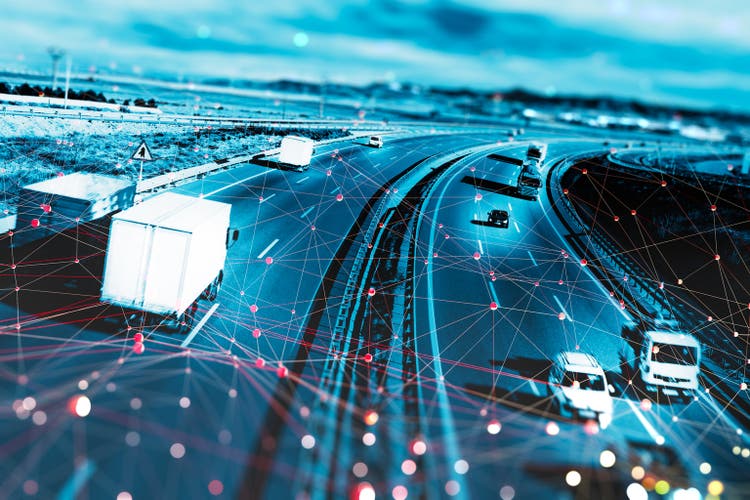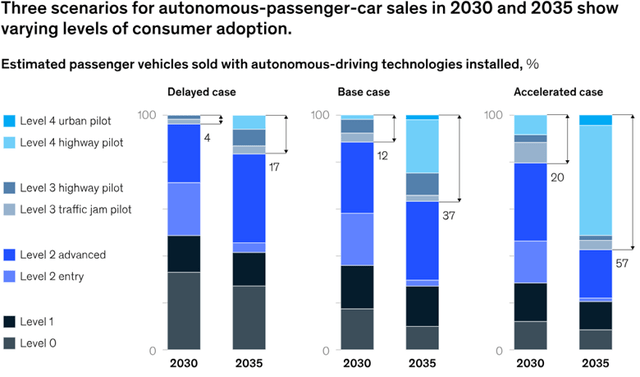Summary:
- Tesla, Inc.’s neural network approach for navigation is feasible, and they should be able to achieve Level 4 autonomy sometime in the future, albeit with certain limitations.
- Tesla’s hardware evolution, from the Mobileye chip in 2014 to their in-house designed chip in 2018, shows continuous advancement in self-driving capabilities.
- Tesla’s recent pattern application of data pipeline and deep learning systems indicates their development in neural networks.
carloscastilla
In order to understand Tesla, Inc. (NASDAQ:TSLA) valuation, a deep dive into their full self-driving (FSD) technology is necessary. There have been numerous marketing hypes and multiple investigations into Tesla electric vehicle (“EV”) crashes in the past. However, I believe Level 4 autonomy could become more commercialized in the coming years. Additionally, I think Tesla’s neural network approach for navigation is feasible, and they should be able to achieve Level 4 autonomy sometime in the future, albeit with certain limitations. Therefore, investors should assign some valuation to their FSD.
Tesla Hardware Evolution
Tesla originally released Autopilot in late 2014 and has been continuously advancing the hardware and software of its self-driving capabilities ever since.
Hardware 1.0 with Mobileye chip: In 2014, Tesla launched Hardware 1.0 chip, which featured the Mobileye Global (MBLY) EyeQ chip. In 2015, the company introduced the first generation of Autopilot, a basic (now standard) package that enables the vehicle to follow other vehicles and auto-steer within a lane, primarily on freeways.
Hardware 2.0 with Nvidia chip: In 2016, Tesla introduced Enhanced Autopilot with upgraded hardware. The new system included a powerful Nvidia (NVDA) AI computer, eight cameras providing a 360-degree view around the vehicle, and improved radar and ultrasonic sensors.
Hardware 3.0 with in-house designed chip: In 2018, Tesla released the Full Self-Driving package, which marked a shift to their own in-house designed chip and the abandonment of the previously used NVIDIA DRIVE PX 2. The new hardware offers 10 times the current processing power and is more cost-effective to produce.
Hardware 4.0: Tesla’s latest suite of Autopilot/self-driving sensors and the new FSD features are included in Hardware 4.0. It incorporates new radar technology and upgraded cameras positioned around the vehicle. This hardware has been deployed in Model S and Model X since 2023.
Although Tesla has made several technology and platform changes over the years, it is understandable as they continuously seek the optimal hardware to support their software, which requires increasingly advanced computing and analytics.
Price of Tesla’s Autonomous Driving Package and Take Rate
Tesla has gradually increased the add-on price for their autonomous driving package. Before 2019, Full Self-Driving was an add-on that required purchasing Enhanced Autopilot, which cost $5,000. Additionally, FSD was a $3,000 add-on if ordered with the vehicle. Tesla raised the price to $10,000 in October 2020, and further increased it to $15,000 in September 2022.
Considering the hardware upgrades and advancements in FSD technology, it is possible that the add-on price could continue to rise over time. Some readers may wonder about the affordability of FSD for consumers in the future. In my previous article about Tesla, I mentioned my belief that the EV market will become commoditized over the next decade, leading to a drop in automotive prices. Consequently, the total cost of EV ownership in the future could be lower than the current levels. Therefore, I don’t anticipate any affordability issues.
Many readers have asked for my thoughts on the assumptions I made regarding the take rate for Tesla in my previous article.
Tesla’s DCF Model-Author’s Calculation
According to McKinsy’s autonomous driving research, in the accelerated base scenario, their estimates suggest that by 2030, 20 percent of new passenger cars will be sold with Level 3+ autonomous technologies, while 57 percent will have advanced AD technologies by 2035. In my model, I anticipate Tesla’s take rate to reach 34% in 2030. Considering Tesla’s leading positions in the market, I believe my estimates are quite reasonable.
McKinsey Center for Future Mobility, The future of autonomous vehicles (AV) | McKinsey
Can Tesla achieve L4 Automation?
Level 4 automation requires the vehicle to perform all driving tasks under certain circumstances, with the option for human override. Currently, Level 4 vehicles are primarily used for taxis and are usually preprogrammed to operate within a limited area with a speed limit of around 30mph.
Waymo’s self-driving fleet, which has been used as taxis in Arizona, San Francisco, and Phoenix, qualifies as Level 4. Cruise, owned by General Motors (GM), opened up its Level 4 robotaxis to a limited portion of the public in San Francisco in 2022. Mercedes (OTCPK:MBGAF) became the first automaker in the U.S. to be certified to sell vehicles with SAE Level 3 autonomous technology and believes that Level 4 autonomy is “doable” by 2030. Volkswagen (OTCPK:VWAGY) aims to commercialize a fleet of Level 4 robotaxis by 2026. Overall, I believe Level 4 autonomy could become more commercialized in the coming years.
Now, let’s discuss Tesla. Tesla has faced delays in releasing their Full Self-Driving software in the past, so Elon Musk’s FSD predictions should be taken with caution. Tesla released its FSD beta to all customers in North America who had paid for it in late 2022, but some individuals consider it to be an unreliable equivalent of Level 2 autonomy.
During the recent World Artificial Intelligence Conference, Elon Musk mentioned that he believes Tesla is very close to achieving full self-driving without human supervision. He predicts that Level 4 or Level 5 autonomy will be incorporated into Tesla’s production vehicles before the end of the year. However, I personally believe that L5 is not feasible with our current technologies and that there is still a significant gap to bridge.
While I think Tesla can achieve Level 4 autonomy in the future, it will likely be limited by geographical and weather conditions where human drivers may need to take over. Elon Musk envisions the use of neural networks in vehicle navigation and control, going beyond their current application in vision processing. This approach, if realized, could be transformative as it would allow cars to navigate without relying solely on map data. Most navigation technologies currently depend on high-definition maps, which is why self-driving works better in major cities than in urban or rural areas. Neural networks can overcome these limitations but require extensive computing power and data processing. I believe that Tesla’s HW 4.0 and Dojo, a supercomputer designed for AI training, have the capability to handle vast amounts of data. In terms of neural networks research, I believe Tesla has an advantage compared to its peers.
In summary, while I cannot say for certain whether Tesla will release new FSD to achieve Level 4 later this year, I believe Tesla’s neural network approach is plausible, and they should be able to achieve Level 4 autonomy in the future, albeit with certain limitations.
Recent Patent Application for data pipeline and deep learning system
When I searched for Tesla’s patent applications on the World Intellectual Property Organization, the most recent one related to autonomous driving caught my attention. The new Tesla patent application is called “Data Pipeline and Deep Learning System for Autonomous Driving.” In this patent application, Tesla describes a solution in which sensors attached to a vehicle provide real-time sensor data, including vision, radar, and ultrasonic data, of the vehicle’s surrounding environment to a neural network. This neural network is then used to determine vehicle control responses, allowing for autonomous operation of the vehicle to some extent. I believe these patent applications demonstrate that Tesla has been actively working on neural network technologies for navigation and control.
Valuation
In my previous article about Tesla, I evaluated the automotive business and FSD technology as separate components. According to my model, the fair value of the auto business without FSD is estimated to be $218 per share. Additionally, I estimate that FSD is worth $176 per share. For more detailed information regarding the model, please refer to my previous article.
Conclusion
All in all, I believe Level 4 autonomy could become more commercialized in the coming years. Despite the marketing hype and multiple investigations into Tesla crashes, I acknowledge Tesla’s technological advancements in both hardware and software. It is unreasonable to consider Tesla solely as an automotive company, as their Full Self-Driving technology should contribute to Tesla’s overall valuation. Furthermore, I believe Tesla’s neural network approach is feasible, and they should be capable of achieving Level 4 autonomy in the future, albeit with certain limitations.
Editor’s Note: This article discusses one or more securities that do not trade on a major U.S. exchange. Please be aware of the risks associated with these stocks.
Analyst’s Disclosure: I/we have no stock, option or similar derivative position in any of the companies mentioned, and no plans to initiate any such positions within the next 72 hours. I wrote this article myself, and it expresses my own opinions. I am not receiving compensation for it (other than from Seeking Alpha). I have no business relationship with any company whose stock is mentioned in this article.
Seeking Alpha’s Disclosure: Past performance is no guarantee of future results. No recommendation or advice is being given as to whether any investment is suitable for a particular investor. Any views or opinions expressed above may not reflect those of Seeking Alpha as a whole. Seeking Alpha is not a licensed securities dealer, broker or US investment adviser or investment bank. Our analysts are third party authors that include both professional investors and individual investors who may not be licensed or certified by any institute or regulatory body.
